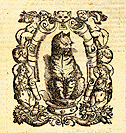& MELCHIOR SESSA AND BROTHERS

1564/1578/1596 Venice: GIOVANNI BATTISTA & MELCHIOR SESSA AND
BROTHERS
The Dante of the commentary tradition enjoyed a renewed fortune in this
series of editions published by the Sessa
family immediately following the Council of Trent (1563) in the religiously
charged atmosphere of the Counter-Reformation. The Florentine editor Francesco
Sansovino dedicated his edition of the poem, which brought together for
the first time under one cover the Landino and Vellutello commentaries,
to Pope Pius IV; with the following words, reflecting an appropriately mannerist
taste for etymological conceit: "... sì come il suggetto di
questo scrittore -- tutto pio, e christiano ..." (... since the subject
matter of this poet is completely pious and Christian ...). Sansovino may
well have been responsible for the innovation of printing both the Landino
and Vellutello commentaries together, in imitation of a practice already
established in the publication of Greek and Latin classics. His own contributions
include interesting additions (titled "Aggiunte del Sansovino")
to Landino's introductory defense of the cultural achievements of the Florentines
in religion, war and the arts. Sansovino adds the names of many of the Florentines
who had distinguished themselves in these fields since Landino's time, including
Michelangelo, Leonardo da Vinci, and his own father Jacopo Sansovino, a
famous sculptor and architect.
Born in Rome in 1521, Francesco Sansovino was brought to Venice following
the sack of his native city in 1527, and there his father obtained an honored
position as engineer. Francesco studied law in Padua and Bologna, and after
attempting a career as courtier at the court of Pope Julius III, he eventually
returned to Venice. There he married and lived quietly until his death in
1583.
Francesco Sansovino typifies the figures who moved in the editorial circles
of the period. A polygraph author of poetry, prose writings on literature,
history and rhetoric, as well as a translator and editor, Sansovino not
only compiled, translated, and annotated text for Venetian printers, he
even opened his own printing house, publishing around thirty editions, many
of good quality, between 1560-62 and in 1568.
None of Sansovino's works are much read today, although many were read widely
during the Renaissance, especially his historical works. His encyclopedic
description of his adopted city, Venetia, città nobilis et singolare,
descritta in XIIII libri (Venezia, 1581), is a useful source for descriptions
of churches, works of art, personalities, famous events, and customs of
the time. He also wrote a history of the Turks in Europe (Annali Turcheschi),
a history of illustrious Italian families (Origini e fatti delle famiglie
illustri d'Italia), a treatise in seven books on the art of writing
letters (Il Secretario), as well as a book on the government of kingdoms
and republics (Del governo dei regni e delle republiche). Sansovino
also found time for writing literary criticism, including studies of Dante,
Petrarch, Ariosto, Bembo and Sannazaro. In this genre, a book about Boccaccio's
Decameron, Lettere sopra le dieci giornate del Decameron(Venice,
1543), is worthy of note.
The portrait of the poet on the title
page is derived from a portrait of Dante by the mannerist painter and
author Giorgio Vasari (1511-1574). It offers a telling contrast to the earlier
more idealized and conventional portraits which had presented the poet as
if on a medallion or coin, in classical profile with toga and laurel.
1564 Edition:
1578 Edition:
These two copies of the Sessa 1578 imprint illustrate how the printer disposed
the Landino and Vellutello commentaries consecutively in double columns,
enclosing between them the glossed segment of text. The Renaissance reader
of this copy heavily annotated his book with underlining and marginal
glosses (a,
b).
It is interesting to note how he apparently ignores the more recent Vellutello
commentary completely. The reader may have owned a Marcolini edition of
the Vellutello commentary but had no other source for the Landino, which
had not been published for more than forty years. He also catches printer's
misattribution of a portion of Landino's commentary to Vellutello.
The illustrations for the Sessa editions, like the one from Paradiso,
were based upon those of the 1544 Marcolini
edition.
1596 Edition:

